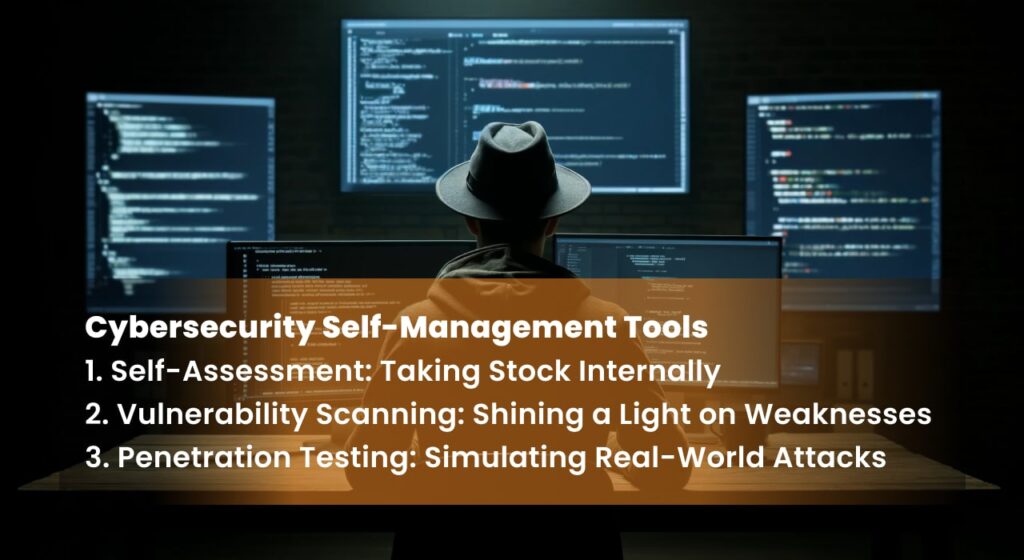
In today’s digitally driven landscape, cybersecurity for SMBs has become an essential, non negotiable element of operational resilience. While many small businesses may mistakenly believe their size shields them from cyberattacks, the reality paints a starkly different picture. According to a 2023 Verizon Business Data Breach Investigations Report, 43% of all cyberattacks targeted small and medium-sized businesses. The repercussions of such transgressions can be significant. A Ponemon Institute study revealed the average total cost of a data breach for a small business to be a staggering $4.24 million, a financial blow that could cripple or even shutter an unsuspecting organization.
To effectively combat this growing threat, small businesses must proactively identify and address vulnerabilities within their cybersecurity posture. A security gap analysis, a systematic assessment of an organization’s cybersecurity risks, offers a critical first step in this process. By pinpointing weaknesses and potential entry points for cybercriminals, a security gap analysis empowers small businesses to prioritize their cybersecurity investments and implement targeted safeguards. This proactive approach not only strengthens a company’s digital defenses but also fosters trust with clients and partners who increasingly value robust data security practices.
What is a Security Gap Analysis?

In the realm of cybersecurity, a security gap analysis (SGA) serves as a methodical evaluation designed to illuminate an organization’s cybersecurity posture. This comprehensive assessment plays a pivotal role in identifying and prioritizing vulnerabilities within a business’s security infrastructure. The SGA process meticulously compares a company’s current security controls against established industry benchmarks and best practices, effectively highlighting areas where defenses may be inadequate or entirely absent. This comparative analysis empowers businesses to pinpoint critical gaps in their cybersecurity framework, enabling them to strategically allocate resources and implement targeted mitigation strategies.
By conducting regular security gap analyses, small businesses can reap a multitude of benefits. Firstly, SGAs provide a clear and objective picture of an organization’s cybersecurity preparedness. This heightened awareness empowers businesses to make informed decisions regarding resource allocation and prioritize investments in the most critical areas. Secondly, SGAs serve as a proactive measure in preventing costly cyberattacks. By identifying and rectifying vulnerabilities before they can be exploited by malicious actors, businesses can significantly reduce the risk of data breaches and their associated financial and reputational repercussions. Finally, regular SGAs can ensure a business remains compliant with industry regulations and data privacy laws, mitigating the risk of legal penalties and reputational damage.
For a more in-depth exploration of security gap analyses and their benefits for businesses, we recommend consulting the following resource: Cybernod Blog: Secure SMBs with Expert Tips. This comprehensive guide delves deeper into the SGA process and its role in safeguarding your small business in the ever-evolving cybersecurity landscape.
Why is Security Gap Analysis Crucial for Small Businesses?

While small businesses are the backbone of the global economy, they often face distinct challenges in the realm of cybersecurity. Unlike their larger counterparts, they may lack dedicated security teams and in-house expertise, leaving them vulnerable to cyberattacks. This disparity is further amplified by the ever-increasing sophistication of cyber threats, making it difficult for small businesses to keep pace without a comprehensive security strategy.
A security gap analysis serves as a vital tool for small businesses to bridge these cybersecurity resource and expertise gaps. This systematic evaluation acts as a proactive measure, illuminating potential weaknesses in a company’s defenses before they can be exploited by malicious actors. Through a meticulous assessment, a security gap analysis offers a multitude of benefits:
- Identification of Exploitable Vulnerabilities: The analysis meticulously examines a business’s security posture, pinpointing weaknesses that could be leveraged by attackers to gain unauthorized access to sensitive data or disrupt critical operations. By proactively identifying these vulnerabilities, businesses can prioritize remediation efforts and bolster their overall cybersecurity posture.
- Highlighting Areas for Security Control Improvement: The analysis goes beyond simply identifying vulnerabilities; it shines a light on areas where existing security controls may be inadequate or entirely absent. This allows businesses to strategically allocate resources and implement targeted mitigation strategies, such as strengthening password policies or deploying advanced firewalls.
- Ensuring Regulatory Compliance: Many industries have specific data security regulations that businesses must adhere to. A security gap analysis helps identify areas where a business’s security controls may fall short of compliance requirements. By addressing these shortcomings, businesses can mitigate the risk of hefty fines and reputational damage associated with non-compliance.
Perhaps the most compelling argument for small businesses to prioritize security gap analyses lies in their cost-effectiveness. Investing in preventative measures through a gap analysis is significantly less expensive than recovering from a cyberattack. Data breaches can incur devastating financial losses, disrupt operations, and severely damage a company’s reputation. Therefore, a security gap analysis serves as a proactive and cost-effective approach to safeguarding a small business’s future in the ever-evolving cybersecurity landscape.
Key Techniques for Security Gap Analysis in SMBs

Equipping small businesses with the tools to conduct their own security gap analyses empowers them to take charge of their cybersecurity posture. This section explores several actionable techniques that can be implemented without requiring extensive resources or specialized expertise.
Self-Assessment: Taking Stock Internally
The cornerstone of any security gap analysis is a thorough internal assessment. This self-evaluation process involves meticulously examining a small business’s current security controls and practices. Questionnaires and checklists specifically designed for small businesses serve as valuable tools in this endeavor. These resources pose a series of targeted questions that delve into critical areas like access control, data security, incident response, and disaster recovery.
Fortunately, numerous readily available resources can streamline the self-assessment process for small businesses. The National Institute of Standards and Technology (NIST) Cybersecurity Framework provides a comprehensive set of guiding principles, including a Small Business Cybersecurity Framework specifically tailored to their needs. This framework offers downloadable self-assessment tools that walk businesses through the process of identifying and prioritizing cybersecurity risks. Additionally, industry associations and cybersecurity vendors often provide free or low-cost self-assessment tools and checklists.
| Security Area | Sample Questions |
|---|---|
| Access Control |
|
| Data Security |
|
| Incident Response |
|
By diligently working through these questionnaires and checklists, small businesses can gain valuable insights into their current cybersecurity posture, pinpointing areas where existing controls may be inadequate or entirely absent.
Vulnerability Scanning: Shining a Light on Weaknesses
Vulnerability scanning is a critical technique that utilizes automated tools to identify weaknesses within a business’s systems and applications. These scanners meticulously comb through software, hardware, and network configurations, searching for known vulnerabilities that malicious actors could exploit to gain unauthorized access or disrupt operations.
The benefits of vulnerability scanning for small businesses are undeniable. By proactively identifying vulnerabilities, businesses can prioritize remediation efforts and patch these weaknesses before they can be leveraged by attackers. Fortunately, several free and paid vulnerability scanning tools cater specifically to the needs of small businesses. Open-source options like OpenVAS or free trials offered by paid vendors can empower businesses to conduct basic vulnerability scans and identify critical security gaps.
Penetration Testing: Simulating Real-World Attacks
Penetration testing, also known as pentesting, takes vulnerability scanning a step further. This technique involves simulating real-world cyberattacks to uncover vulnerabilities that automated scanners might miss. A qualified penetration tester, often referred to as a white hat hacker, ethically attempts to exploit weaknesses in a business’s security defenses, mirroring the tactics employed by malicious actors. The results of a pentesting exercise provide invaluable insights into the effectiveness of existing security controls and highlight areas where attackers might gain a foothold.
While pentesting can be a highly effective tool for uncovering critical vulnerabilities, small businesses with limited resources might hesitate due to the perceived cost. However, the potential benefits of pentesting far outweigh the initial investment. By identifying and addressing vulnerabilities before a real attack occurs, businesses can significantly reduce the risk of data breaches and the associated financial and reputational repercussions.
An alternative solution for resource-constrained businesses is a bug bounty program. These programs incentivize ethical hackers to identify and report vulnerabilities within a business’s systems or applications. In exchange for successfully identifying a vulnerability, the hacker receives a predetermined bounty. Bug bounty programs offer a cost-effective way to leverage the expertise of a large pool of security researchers and continuously improve a business’s security posture.
By implementing a combination of self-assessment techniques, vulnerability scanning, and potentially even bug bounty programs, small businesses can conduct effective security gap analyses and proactively address their cybersecurity vulnerabilities. This proactive approach empowers them to confidently navigate the ever-evolving threat landscape and safeguard their sensitive data in the digital age.
Considering the Cloud? Security gap analyses often reveal vulnerabilities associated with cloud environments, especially for businesses heavily reliant on cloud-based solutions. For a more in-depth exploration of cloud security best practices, we recommend our comprehensive guide: Cloud Security: Safeguarding Your Data Within the Cloud. This resource offers actionable insights to help you bolster your cloud security posture and minimize cybersecurity risks.
Prioritization and Remediation: Addressing the Gaps

A security gap analysis equips small businesses with a comprehensive roadmap, but the journey doesn’t end there. The identified vulnerabilities must be strategically addressed to fortify a business’s overall security posture. This critical stage involves prioritizing the identified security gaps based on two key factors: potential impact and exploitability.
Potential impact refers to the severity of the consequences that could arise if a vulnerability is exploited. This includes the potential for data breaches, financial losses, operational disruptions, and reputational damage. Exploitability considers the likelihood of an attacker successfully leveraging a vulnerability. Factors such as the ease of exploitation and the existence of publicly known exploits influence this assessment.
By carefully considering both impact and exploitability, small businesses can prioritize their remediation efforts, focusing on vulnerabilities that pose the greatest risk. This prioritization ensures that resources are allocated effectively, maximizing the return on investment in cybersecurity measures.
The process of remediation involves taking concrete steps to address the identified vulnerabilities. Common remediation strategies include:
- Patching Software: Regularly applying security patches to software applications and operating systems is fundamental. These patches often address newly discovered vulnerabilities, significantly reducing the attack surface for malicious actors.
- Implementing Additional Security Controls: Depending on the specific vulnerabilities identified, additional security controls may be necessary. This might involve implementing multi-factor authentication protocols, strengthening access controls, or deploying firewalls to further safeguard sensitive data and systems.
- User Awareness Training: Empowering employees with cybersecurity awareness training plays a crucial role in mitigating risks. By educating employees on how to recognize and avoid phishing attempts, identify suspicious activity, and report security incidents, businesses significantly reduce the human element of cybersecurity risk.
A successful security gap analysis is not a one-time event; it should be an ongoing process. By regularly conducting security gap analyses and diligently addressing identified vulnerabilities, small businesses can take proactive steps to bolster their cybersecurity posture and safeguard their sensitive data in the ever-evolving digital threat landscape.
Best Practices & Considerations: Optimizing Your Security Gap Analysis

To maximize the effectiveness of their security gap analysis endeavors, small businesses should adhere to several best practices:
- Regular Assessments: The cybersecurity threat landscape is constantly evolving. To ensure their defenses remain robust, small businesses should conduct security gap analyses at regular intervals. A recommended schedule could be annually or biannually, depending on the nature and risk profile of the business.
- Stakeholder Involvement: A security gap analysis is not a solitary endeavor. Involving key stakeholders from various departments within the organization fosters a comprehensive approach. Representatives from IT, finance, human resources, and legal departments can offer valuable insights based on their unique perspectives.
- Documentation is Key: The findings gleaned from a security gap analysis are invaluable assets. Meticulously documenting the process, identified vulnerabilities, and implemented remediation strategies serves several purposes. It facilitates ongoing monitoring of progress, allows for future comparisons to track improvements and provides a clear audit trail for compliance purposes.
While self-conducted security gap analyses offer significant benefits for small businesses, it’s crucial to acknowledge their limitations. The complexity of the cybersecurity landscape, coupled with the potential lack of in-house expertise, can make it challenging to identify all vulnerabilities. In such instances, seeking professional assistance from cybersecurity experts can be highly beneficial. These specialists possess the profound knowledge and experience to conduct a more thorough analysis, potentially uncovering hidden weaknesses and recommending tailored remediation strategies.
By following these best practices and considering the potential advantages of professional assistance, small businesses can elevate their security gap analysis efforts to a new level, effectively safeguarding their sensitive data and bolstering their overall cybersecurity posture.
In today’s digital landscape, a robust cybersecurity posture is no longer a luxury for small businesses; it’s a fundamental necessity. By conducting regular security gap analyses, small businesses can proactively identify and address vulnerabilities in their defenses, significantly reducing their risk of data breaches and the associated financial and reputational repercussions. This comprehensive guide has equipped you with the knowledge and actionable techniques to conduct your own security gap analysis. Remember, a proactive approach to cybersecurity is paramount. For additional resources on preventing data breaches and exploring free cybersecurity resources specifically designed for small businesses, numerous online sources are readily available.
Categorized in:
Comments